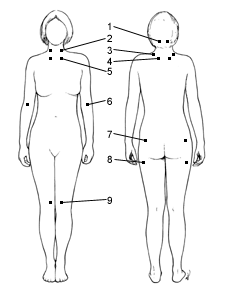
Am Fam Physician. 2000;61(9):2821-2822
Fibromyalgia is characterized by chronic, widespread musculoskeletal pain and stiffness in association with fatigue, poor sleep and discrete tender points. It occurs most commonly in women in their mid-30s to late 50s. Leventhal reviewed the literature on the diagnosis and treatment of fibromyalgia.
The diagnostic criteria for fibromyalgia, developed in 1990 under the auspices of the American College of Rheumatology, are described in the accompanying table and figure. Fatigue or stiffness on awakening is a common symptom of fibromyalgia. Other features include irritable bowel syndrome, Raynaud syndrome–like symptoms, headache, subjective swelling, nondermatomal paresthesia, psychologic distress and significant functional disability.
| Widespread pain of at least 3 months' duration |
| Axial skeletal pain |
| Pain in at least 11 of 18 tender points on digital palpation with an approximate force of 4 kg per cm |

The cause and pathophysiology of fibromyalgia are unknown. A variety of pathophysiologic alterations have been found in clinical studies, including disturbance of non–rapid-eye-movement sleep, alterations in muscle fibers, impaired function of the hypothalamic-pituitary-adrenal axis, decreased serotonin levels and decreased regional cerebral blood flow. The author states that adequate evidence supports neurotransmitter abnormalities in the pathophysiology of fibromyalgia. He notes that it is unclear whether sleep disorders are a cause or a result of the disorder. He believes, based on current evidence, that impaired muscle metabolism or muscle blood flow is unlikely to have a role in the pathophysiology of fibromyalgia.
Studies indicate that treatment of fibromyalgia is often unsuccessful, with fewer than 50 percent of patients experiencing adequate relief of symptoms. Antidepressants, analgesics and other agents are commonly used. Tricyclic antidepressants may be beneficial by inhibiting reuptake of serotonin and, possibly, norepinephrine. Amytriptyline, the antidepressant most commonly prescribed in the treatment of fibromyalgia, has been found to alleviate symptoms in some patients. Three studies of fluoxetine produced equivocal results regarding the use of this selective serotonin reuptake inhibitor in the treatment of fibromyalgia. Improvement in depression and sleep disturbance was observed, but no effect on relief of pain at tender points was found.
Analgesics such as tramadol may provide pain relief. A double-blind, placebo-controlled study of 100 patients revealed that 27 percent of the patients who took tramadol withdrew from the study because of inadequate pain relief; 57 percent of the placebo group withdrew because of poor pain relief. Anti-inflammatory drugs have not been found to be useful in the treatment of fibromyalgia.
Lidocaine injections at tender points may offer some benefit. A study of lidocaine injections in patients with fibromyalgia and myofascial pain revealed that patients with fibromyalgia experienced more postinjection soreness. The efficacy of opioid analgesics has not been evaluated in patients with fibromyalgia.
Nonpharmacologic treatments for fibromyalgia include exercise, biofeedback, hypnotherapy, acupuncture and cognitive-behavioral therapy. Studies suggest that aerobic exercise three times a week can reduce pain in tender points. Studies of biofeedback show that this technique results in significant decreases in the number of tender points, overall pain intensity and morning stiffness. A controlled study that compared eight sessions of hypnotherapy and physical therapy showed that patients with refractory fibromyalgia experienced greater benefit from hypnotherapy than from physical therapy. The author notes, however, that this study had a selection bias in favor of hypnotherapy. Patients in the study had already demonstrated refractoriness to physical therapy. Acupuncture was shown in one study to result in improvement in five of eight outcome measures; approximately one fourth of the patients had complete remission of symptoms.
Studies of cognitive-behavioral therapies have reported at least some benefit. A prospective study of intensive cognitive intervention versus less structured group discussions about pain and coping revealed similar efficacy with these two approaches. Similar results were observed in a study that compared relaxation training with integrated group therapy. The author notes that efficacy may have been dampened by the long duration of fibromyalgia in the study participants. Thus, behavioral therapy may hold more promise in patients with fibromyalgia of more recent onset.